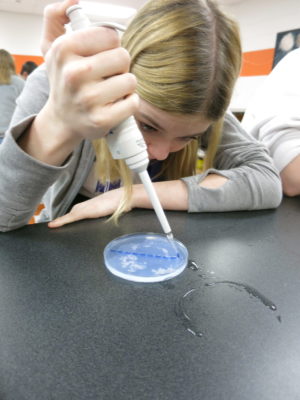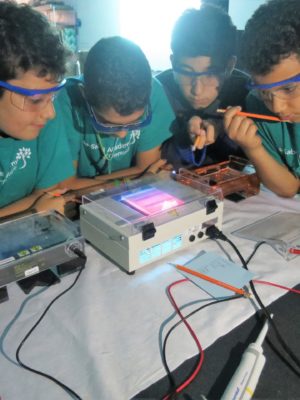Science lab opportunities for homeschool co-ops at Clemson University!



WHERE? Basement of Jordan Hall (G26-G30), Clemson University
COST? See pricing scheme through ‘Fees and Payment’ button
WHEN? See availability calendar through the ‘Make a Reservation’ button
QUESTIONS? culsoc@clemson.edu or 864-656-9939
Acids and Bases
(ages 8–12)
In this lab, students will:
- Discover the difference between acids and bases
- Investigate indicators
- Explore how electricity can produce acids or bases
- Use indicators to test common materials
Air Pressure and Flight
(ages 8-12)
In this lab, students will:
- Explore air pressure using bottles and balloons
- Discover Bernoulli’s principle
- Apply principles of air pressure to flight
The Amazing Life of Honey Bees
(ages 8–12)
In this lab, students will:
- Discuss honey bees and their role in pollination
- Explore the honey bee life cycle
- Observe dead honey bees using a microscope
- Design, build, and test a pollination device
Chemistry in Art
(ages 8-12)
In this lab, students will:
- Harness chemical and physical reactions to create art
- Learn about acids, bases, and indicators
- Discover polarity and how it can make molecules move
Chromatography
(ages 8-12)
In this lab, students will:
- Learn the science behind chromatography
- Discover the colors that make candy bright
- Separate mixtures of color with paper chromatography
- Create art with chromatography spinners
DNA Fingerprinting/Crime Scene
(ages 8-12)
In this lab, students will:
- Discover/review the location and the role of DNA in our bodies
- Perform gel electrophoresis to compare DNA from suspects to DNA found at the crime scene
- Explore how genetic signatures are used in forensics and other applications
- Discuss how environmental and genetic factors influence organisms
Effect of Chemicals on Plant Cells
(ages 8-12)
In this lab, students will:
- Learn about the electromagnetic spectrum and how we see color
- Discover how a spectrophotometer detects absorbance of light
- Discuss parts of the plant cell, including the function of the vacuole
- Analyze data by constructing graphs
- Form a conclusion based on experimental results
- Build a model cell using dialysis tubing
- Explore how a cell membrane controls what enters and exits the cell
- Observe typical animal and plant cells using a compound microscope
Enzymes
(ages 8-12)
In this lab, students will:
- Explore enzymes in the foods we eat
- Discover the properties of enzymes and what makes them work and not work
- Build apple juice filters to determine if an enzyme can make a liquid clearer
Forensic Methodology
(ages 8-12)
In this lab, students will:
- Use microscope to evaluate “poison powders”
- Preform chemical analysis on “poison powders”
- Investigate blood typing
- Inspect fingerprints
Light and Color
(ages 8–12)
In this lab, students will:
- Learn about the electromagnetic spectrum and how we see color
- Explore light, color, and diffraction by building a spectroscope
- Design and build a kaleidoscope
- Investigating how light can play tricks on our eyes
Magnetism and Electricity
(ages 8–12)
In this lab, students will:
- Discover how electricity and magnets can work together
- Use simple materials to create and test your own “battle bot”
* The cost of this lab is $23.00, which includes a motor and battery for each students’ “Battle bot”. Students will be able to take their “battle bot” home with them after the lab. *
Mystery of the Dead Hemlock
(ages 8-12)
In this lab, students will:
- Create a mixture and make observations about its properties as its state of matter changes
- Learn techniques to micropipette and measure small quantities of liquids
- Discover and identify elements in the hemlock ecosystem, including producers, consumers, and decomposers
- Perform gel electrophoresis to compare DNA from known pests to an unknown tree killer (scientists use this method to separate out parts of a mixture)
- Discuss possible solutions communities can use to stop the unknown tree killer and save the hemlock ecosystem
Osmosis and Diffusion
(ages 8–12)
In this lab, students will:
- Use change in mass to determine if osmosis has occurred
- Participate in the “Challenge of the Barriers” to explore diffusion
- Apply diffusion to mobilize color
Polymers
(ages 8–12)
In this lab, students will:
- Create polymer models
- Discuss natural and synthetic polymers
- Explore the properties of polymers while designing a delayed-release pill
- Create polymer art with Shrinky Dinks
Rockets
(ages 8–12)
In this lab, students will:
- Learn about the 4 forces of flight
- Experiment with Newton’s 3 laws of motion
- Design, build, and launch compressed air rockets
The Dyes We Digest
(ages 13+)
In this lab, students will:
- Collect quantitative data using a spectrophotometer.
- Prepare dilutions using micropipettes.
- Determine the wavelength of maximum absorbance for a specific dye.
- Determine solution concentrations.
- Analyze data by constructing graphs.
- Apply data and graphs to find an unknown value.
- Calculate the concentration of food dye in sports drink using Beer’s Law
- Calculate percent error
 University Home
University Home College of Science
College of Science Prospective Students
Prospective Students Give
Give